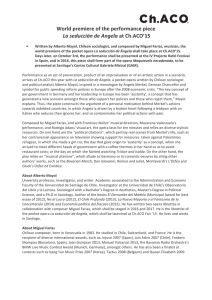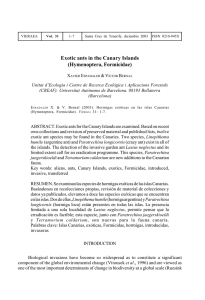Multiobjective Max-Min Ant System. An application to Multicast
Anuncio
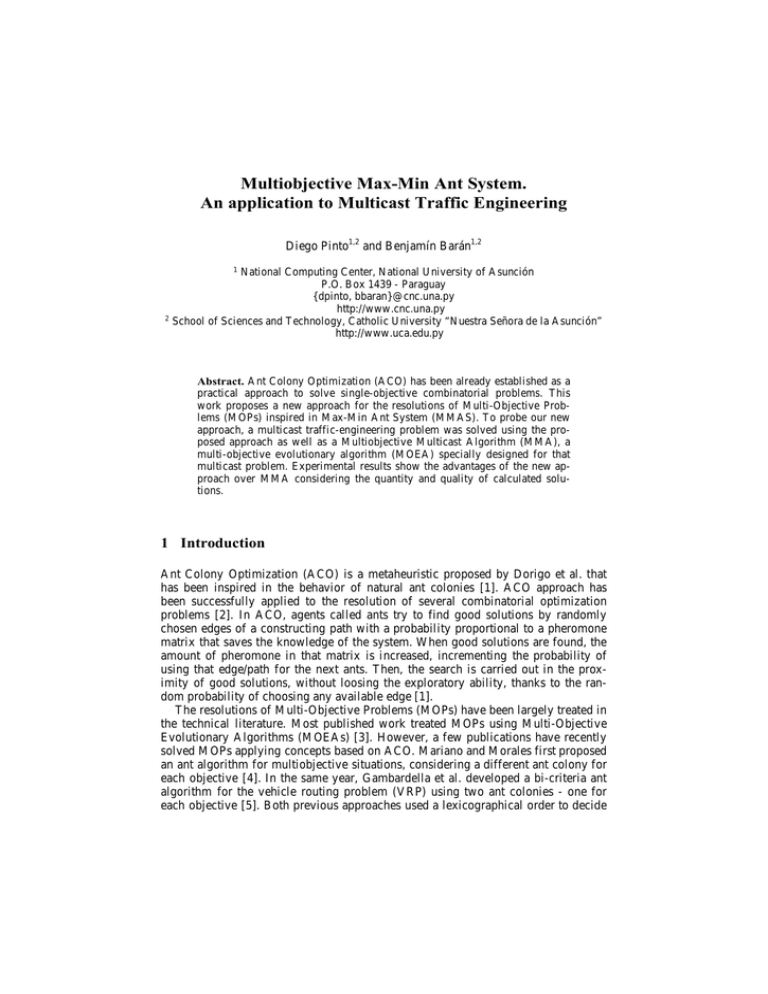
Multiobjective Max-Min Ant System.
An application to Multicast Traffic Engineering
Diego Pinto1,2 and Benjamín Barán1,2
1
National Computing Center, National University of Asunción
P.O. Box 1439 - Paraguay
{dpinto, bbaran}@cnc.una.py
http://www.cnc.una.py
2
School of Sciences and Technology, Catholic University “Nuestra Señora de la Asunción”
http://www.uca.edu.py
Abstract. Ant Colony Optimization (ACO) has been already established as a
practical approach to solve single-objective combinatorial problems. This
work proposes a new approach for the resolutions of Multi-Objective Problems (MOPs) inspired in Max-Min Ant System (MMAS). To probe our new
approach, a multicast traffic-engineering problem was solved using the proposed approach as well as a Multiobjective Multicast Algorithm (MMA), a
multi-objective evolutionary algorithm (MOEA) specially designed for that
multicast problem. Experimental results show the advantages of the new approach over MMA considering the quantity and quality of calculated solutions.
1 Introduction
Ant Colony Optimization (ACO) is a metaheuristic proposed by Dorigo et al. that
has been inspired in the behavior of natural ant colonies [1]. ACO approach has
been successfully applied to the resolution of several combinatorial optimization
problems [2]. In ACO, agents called ants try to find good solutions by randomly
chosen edges of a constructing path with a probability proportional to a pheromone
matrix that saves the knowledge of the system. When good solutions are found, the
amount of pheromone in that matrix is increased, incrementing the probability of
using that edge/path for the next ants. Then, the search is carried out in the proximity of good solutions, without loosing the exploratory ability, thanks to the random probability of choosing any available edge [1].
The resolutions of Multi-Objective Problems (MOPs) have been largely treated in
the technical literature. Most published work treated MOPs using Multi-Objective
Evolutionary Algorithms (MOEAs) [3]. However, a few publications have recently
solved MOPs applying concepts based on ACO. Mariano and Morales first proposed
an ant algorithm for multiobjective situations, considering a different ant colony for
each objective [4]. In the same year, Gambardella et al. developed a bi-criteria ant
algorithm for the vehicle routing problem (VRP) using two ant colonies - one for
each objective [5]. Both previous approaches used a lexicographical order to decide
the order of importance of each objective, i.e. no two objectives may have the same
importance.
Iredi et al. proposed an approach for bi-criteria optimization based on multiple
ant colonies without considering a lexicographical order [6]. In the same year,
Schaerer and Barán presented a Multi-Objective Ant Colony System (MOACS) for
the vehicle routing problem with time windows [7]. This was the first approach to
use only one colony to simultaneously optimize all the objectives without a priori
restrictions.
On the other hand, the Max-Min Ant System (MMAS) was presented by Stützle
and Hoos to solve single objective problems (SOPs) [8]. MMAS is an ACO inspired
algorithm, which successfully solves several combinatorial problems such as the
Traveling Salesman Problem (TSP). This algorithm is considered one of the bestknown ACO thanks to its ability to overcome stagnation by using an upper and a
lower level of pheromone [8]. Given the recognized success of this algorithm, this
work presents a new Multiobjective algorithm based of MMAS that will be called
M-MMAS, or simply M3AS. This new approach simultaneous optimize all objective functions without a priori restrictions, finding a whole Pareto set in only one
run of the algorithm.
To verify the performance of the proposed algorithm, a traditional Multiobjective Multicast Routing problem was solved [9]. M3AS was compared to a
MOEA specially designed to solve that traffic engineering (TE) problem, the recently published Multiobjective Multicast Algorithm (MMA) [9] based on the
Strength Pareto Evolutionary Algorithm (SPEA) [10].
The remainder of this paper is organized as follows. Section 2 gives a general
definition of a Multi-Objective Problem (MOP). The Test problem is presented in
Section 3. A new Multiobjective Max-Min Ant System (M3AS) is presented in Section 4. The Multiobjective Multicast Algorithm (MMA) is summarized in Section 5.
The experimental environment is shown in Section 6. Finally, experimental results
are discussed in Section 7 while the conclusions are left for Section 8.
2
Multi-Objective Problem Formulation
A general Multi-objective Optimization Problem [3] includes a set of n decision
variables, k objective functions, and m restrictions. Objective functions and restrictions are functions of decision variables. This can be expressed as:
Optimize y = f(x) = (f1(x), f2(x), ... , fk(x)).
Subject to e(x) = (e1(x), e2(x), ... ,em(x)) 0,
where
x = (x1, x2, ..., xn) X is the decision vector,
and
y = (y1, y2, ... , yk) Y is the objective vector.
X denotes the decision space while the objective space is denoted by Y. Depending
on the kind of the problem, “optimize” could mean minimize or maximize. The set
of restrictions e(x 0 determines the set of feasible solutions Xf X and its corresponding set of objective vectors Yf
Y. The problem consists in finding x that
optimizes f(x). In general, there is no unique “best” solution but a set of solutions,
none of which can be considered better than the others when all objectives are si-
multaneously taken into account. This derives from the fact that there can be conflicting objectives. Thus, a new concept of optimality should be established for
MOPs. Given two decision vectors u, v Xf :
f(u) = f(v) iff ∀i {1,2,...,k}: fi(u) = fi(v)
f(u)
f(v) iff ∀i {1,2,...,k}: fi(u)
fi(v)
f(u) < f(v) iff f(u)
f(v) f(u)
f(v)
Then, in a minimization context, they comply with one and only one of three possible conditions:
u v (u dominates v),
iff: f(u)<f(v)
v u (v dominates u),
iff: f(v)<f(u)
u ~ v (u and v are non-comparable), iff: f(u) f(v) f(v) f(u)
Alternatively, for the rest of this work, u
v will denote that u dominates or is
equal to v. A decision vector x Xf is non-dominated with respect to a set Q Xf
iff: u v, ∀v Q. When x is non-dominated with respect to the whole set Xf, it is
called an optimal Pareto solution; therefore, a Pareto optimal set Xtrue may be formally defined as:
Xtrue ={x Xf | x is non-dominated with respect to Xf}.
The corresponding set of objective vectors Ytrue=f(Xtrue) constitutes the Optimal
Pareto Front.
3 The Test Problem
The test problem used in this paper is the Multicast Routing Problem [9] defined as
the construction of a Multicast Tree in a computer network to route a given traffic
demand from a source to one or more destinations. The computer network topology
is modeled as a direct graph G=(V, E), where V is the set of nodes and E is the set of
links. The rest of the paper uses the following notation:
(i, j) ∈ E:
Link from node i to node j; i, j ∈ V.
+
cij ∈ ℜ :
Cost of link (i, j).
+
Delay of link (i, j).
+
Capacity of link (i, j), measured in Mbps.
+
tij ∈ ℜ :
s ∈ V:
Nr V-{s}:
ni ∈ Nr
+
φ∈ ℜ :
T(s, Nr):
pT(s, ni) T(s, Nr):
Current traffic of link (i, j), measured in Mbps.
Source node of a multicast group.
Set of destinations of a multicast group.
One of |Nr| destinations, where |.| indicates cardinality.
Traffic demand in Mbps.
Multicast tree with source in s and set of destinations Nr.
Path connecting source s to a destination ni∈Nr. Note
that T(s, Nr) represent a solution x in Section 2.
d(pT(s, n))
Delay of path pT(s, n) given by:
dij ∈ ℜ :
zij ∈ ℜ :
d ( pT (s, n )) =
∑
( i , j )∈ pT ( s , n )
d ij
∀ n ∈ Nr
(1)
Using the above definitions, a multicast routing problem for Traffic Engineering
may be stated as a MOP that tries to find a multicast tree T(s, Nr), simultaneously
minimizing the following objectives:
- Cost of the multicast tree:
C (T ) = φ
-
•
∑ cij
( i , j )∈T
Maximum end-to-end delay of the multicast tree:
DM (T ) = Max
{d ( pT (s, n ))}
n∈N
r
-
(2)
(3)
Average delay of the multicast tree:
DA(T ) =
1
•
Nr
∑ d ( pT (s, n ))
n∈N r
The problem is subject to the link capacity constraint φ+tij
For the rest the work T(s, Nr) ≡ T for simplicity.
(4)
zij ∀(i, j) ∈ T(s, Nr).
4 Ant Colony Optimization Approach
Ant Colony Optimization (ACO) is a metaheuristic inspired by the behavior of natural ant colonies [1]. In the last few years, ACO has received increased attention by
the scientific community as can be seen by the growing number of publications and
the different fields of application [8]. Even though, there are several ACO variants
that can be considered, a standard approach is next presented [11].
4.1 Standard Approach
ACO uses a pheromone matrix τ = {τij} for the construction of potential good solutions. The initial values of τ are set τij = τ0 ∀(i, j), where τ0 > 0. It also takes advantage of heuristic information using ηij = 1/dij. Parameters α and β define the relative
influence between the heuristic information and the pheromone levels. While visiting node i, Ni represents the set of neighbor nodes that are not visited yet. The probability (pij) of choosing a node j at node i is defined in the equation (5). At every
generation of the algorithm, each ant of a colony constructs a complete solution T
using (5), starting at source node s. Pheromone evaporation is applied for all (i, j)
according to τij = (1 - ρ) τij, where parameter ρ ∈ (0; 1] determines the evaporation
rate. Considering an elitist strategy, the best solution found so far Tbest updates τ
•
according to τij = τij + ∆τ, where ∆τ = 1/l(Tbest) if (i, j) ∈ Tbest and ∆τ = 0 if (i, j) ∉
Tbest.
τ ij ⋅ηij
if j ∈ N i
α
β
pij = ∑∀g∈Ni τ ig ⋅ηig
0
otherwise
α
4.2
β
(5)
Multiobjective Max-Min Ant System
The standard Max-Min Ant System (MMAS) presented by Stützle and Hoos [8], was
derived from the standard ACO and it incorporated three key features to achieve a
better performance:
− Only the best solution at every iteration or during the execution of the algorithm updates the pheromone trail τ.
− To avoid stagnation, the possible range of τ components is limited to an interval [τmin, τmax]. The upper level may be calculated as τmax = ∆τ/(1-ρ) while the
lower level as τmin = τmax/2·ω, where ω is the quantity of ants at each generation.
− Initialize the pheromone trails by setting τ0 to some arbitrarily high value,
achieving a high exploration at the start of the algorithm.
To solve multiobjective problems, the present work modifies MMAS with the following changes:
− M3AS finds a whole set of Pareto optimal solutions called Yknow instead of
finding a single optimal solution.
− To guide the ants in the search space, two heuristics information are proposed,
inspired in Schaerer and Barán [7]: ηcij = 1/cij and ηdij = 1/dij. Parameters λc
and λd define the relative influence between the two heuristics information.
Let’s consider the k-th ant. Then, the proposed heuristic uses λc=k and λd= (ω
k+1), where k ∈ {1, 2, , ω} and ω is the total number of ants. Therefore the
probability of choosing a node j at node i is defined as:
τ ij ⋅(ηij ) c ⋅(ηij ) d
d λd β
c λc β
α
pij = ∑∀g∈Ni τ ig ⋅(ηig ) ⋅(ηig )
0
α
−
c λ β
d λ β
if j ∈ N i
The pheromone level ∆τt is now calculated for each solution Tt ∈ Yknow, and it
is given by:
∆τ t' = C (Tt )+ DM 1(Tt ) + DA(Tt )
−
(6)
otherwise
(7)
The pheromone matrix τ is updated according to τij = τij + ∆τt , ∀ (i, j) ∈ Tt
and ∀Tt ∈ Yknow up to an upper level τmax = ∆τt /(1-ρ) and not below a minimum level τmin = ∆τt /2·ω·(1-ρ).
The main algorithm of the new M3AS approach is presented in the Fig. 1 while
Fig. 2 details the algorithm to build a solution tree T, called Build Tree.
Begin M3AS
Read α, β, ρ, φ, (s, Nr), tij; τij = τ0 ∀(i, j) ∈ E; Yknow= Ø;
Do {
For k = 1 until ω repeat
λc = k; λd = ω k+1;
Tk = Build Tree (λc, λd, α, β, φ, τij, (s, Nr), tij)
If (Tk ∈ Yknow) then
Yknow = Yknow ∪ Tk - {TY| Tk f TY} ∀TY ∈ Yknow
End If
End For
τij = (1 - ρ) τij ∀(i, j) ∈ E
if τij <τmin then τij = τmin ∀(i, j) ∈ E
Repeat ∀Tt ∈ Yknow
τij = τij + ∆τt ∀(i, j) ∈ T
if τij >τmax then τij = τmax ∀(i, j) ∈ Tt
End Repeat
} while stop criterion is not verified
Return Yknow
End M3AS
•
Fig. 1. Main M3AS algorithm. Initially it reads the parameters and initializes the pheromone
matrix τ and a set Pareto Yknow. At each generation, ω solutions Tk are built. The set Yknow is
updated with non-dominated solutions Tk and dominated solutions of Yknow are eliminated. To
update pheromone matrix τ, evaporation is first performed pheromones are latter added ∀(i, j)
∈ T and ∀T ∈ Yknow.
Begin Build Tree
Read λc, λd, α, β, φ, τij, (s, Nr), tij ; T = Ø; N=s;
Repeat until found all nodes destinatios of the Nr
Choose randomly of node i of the N
Create list of feasible neighbors Ni to the node i
Choose randomly of node j of the Ni using p ij
T = T ∪ (i, j); N = N ∪ j;
End Repeat
Prune Tree T /* Not used connections are eliminated
Return T
End Build Tree
Fig. 2. This algorithm builds a solution T. After initialization, the main cycle randomly
choose a node i from a set N of possible departure nodes. A list Ni of feasible neighbors to i
is then created to randomly choose a node j using probability pij (equation 6). The link (i, j)
is included in T while j is included to N. When reaching all Nr nodes, the useless links are
eliminated and the algorithm is stop.
5
Multiobjective Multicast Algorithm
Multiobjective Multicast Algorithm (MMA), recently proposed in [9], is based on
the Strength Pareto Evolutionary Algorithm (SPEA) [10]. MMA holds an evolutionary population P and an external Pareto solution set Pnd. Starting with a random
population P of solutions, the individuals evolve to Pareto optimal solutions to be
included in Pnd. The pseudo-code of the main MMA algorithm is shown in Fig. 3(a),
while its codification is represented in Fig. 3(b).
Begin MMA
Read (s, Nr) , tij and φ
Build routing tables
Initialize P
Do {
Discard individuals
Evaluate individuals
Update non-dominated set Pnd
Compute fitness
Selection
Crossover and mutation
} while stop criterion is not verified
End MMA
(a)
(b)
Fig. 3. (a) Pseudo-code of main MMA algorithm (b) Relationship between a chromosome,
genes and routing tables for a tree with s=0 and Nr={2, 3}
The MMA algorithm begins reading the variables of the problem and basically
proceeds as follows (see pseudo-code in Fig. 3(a)):
Build routing tables: For each ni ∈ Nr, a routing table is built. It consists of the R
shortest and R cheapest paths. R is a parameter of the algorithm. A chromosome is
represented by a string of length |Nr| in which each element (gene) gi represents a
path between s and ni. See Fig. 3(b) to see a chromosome that represents the tree in
Fig. 3(b).
Discard individuals: In P, there may be duplicated chromosomes. Thus, new randomly generated individuals replace duplicated chromosomes.
Evaluate individuals: The individuals of P are evaluated using the objective functions. Then, non-dominated individuals of P are compared with the individuals in
Pnd to update the non-dominated set, removing from Pnd dominated individuals.
Compute fitness: Fitness is computed for each individual, using SPEA procedure
[10].
Selection: Traditional tournament or roulette methods may be used [12]. To facilitate comparison of the proposed algorithm to MMA [9], a roulette selection operator
is applied over the set Pnd ∪ P to generate the next evolutionary population P.
Crossover and Mutation: MMA uses two-point crossover operator over selected pair
of individuals. Then, some genes in each chromosome of the new population are
randomly changed (mutated), obtaining a new solution.
The process continues until a stop criterion, as a maximum number of generations, is satisfied.
6
Experimental Environment
Simulations were carried out using the NTT network topology illustrated in Fig. 4
[9]. Two multicast groups shown in Table 1 were used for the presented experiments. For each group, experimental results are analyzed after 160 and 320 seconds.
Initially, the network was considered 50% randomly loaded on average, i.e. the
initial traffic tij is around 50% of its total load capacity zij.
Fig. 4. “Japan NTT network” with 55 nodes and 144 links used for the simulations. Over
each link (i, j), a delay dij is shown.
Two algorithms (M3AS and MMA) have been implemented on a 350 MHz AMDK6 computer with 128 MB of RAM. A Borland C++ V 5.02 compiler was used. For
these experiments, the results of the proposed M3AS were compared to the evolutionary algorithm MMA [9], summarized in Section 5.
The MMA parameters were |P| = 40, R = 25 and Pmut = 0.3 and the parameters
selected for the M3AS were α = 1, β = 10, ρ = 0.7, τ0 = 10 and ω = 10.
Table 1. Multicast Group used for the tests. Each Group has one source and |Nr| destinations.
Test
Group
Group 1
(small)
Group 2
(large)
Source
{s}
Destinations
{Nr}
|Nr|
5
{0, 1, 8, 10, 22, 32, 38, 43, 53}
9
4
{0, 1, 3, 5, 6, 9, 10, 11, 12, 17, 19, 21, 22, 23, 25,
33, 34, 37, 41, 44, 46, 47, 52, 54}
24
To calculate an approximation to the true Pareto Front, Yapr, the following six-step
procedure was used:
1. Each algorithm (M3AS & MMA) was run five times and an average was calculated for comparison to each other.
2. For each algorithm, five sets of non-dominated solutions: Y1, Y2…Y5, were
calculated, one for each run.
5
3. For each algorithm, an overpopulation YT was obtained, where YT = U Y .
i =1
i
4. Dominated solutions were deleted from YT, obtaining the Pareto Front calculated by each algorithm, as follows:
YM3AS
(Pareto Front obtained with five runs, using M3AS),
YMMA
(Pareto Front obtained with five runs, using MMA).
∧
∧
5. A set of solutions Y was obtained as: Y = YM 3 AS ∪ YMMA .
∧
6. Dominated solutions were deleted from Y , and an approximation of Ytrue,
called Yapr, is finally created. Note that for practical issues Yapr ≈ Ytrue, i.e. Yapr
is an excellent approximation of Ytrue.
Table 2 presents the total number of solutions |Yapr| that were experimentally
found for each multicast group.
Table 2. Total number of non-dominated solutions belonging to Yapr for each multicast
group.
|Yapr|
7
Group 1 (small) Group 2 (large)
9
18
Experimental Results
The following tables show a comparison between the solutions found with both
implemented algorithms (M3AS & MMA) with respect to Yapr. At the same time,
both algorithms are compared using the coverage figure of merit that counts the
average number of solutions dominated by the other algorithm’s Pareto set [3, 10],
as shown in tables 3 to 6. To understand those tables, the following notation is used:
∈Yapr
average number of solutions found by each algorithm’s runs that are in
Yapr;
Yaprf
average number of solutions found by each algorithm’s runs that are
dominated by Yapr;
|Yalgorithm| average number of solutions found by each algorithm;
%(∈Yapr) percentage of solutions found by an algorithm, i.e. 100 (∈Yapr)/ |Yapr|.
•
7.1
Experiment 1. Results obtained for a small multicast Group 1
Tables 3 and 4 present experimental results obtained for multicast group 1 after a
run of 160 seconds and 320 seconds respectively. Both tables show that M3AS found
more solutions than MMA. The coverage value of zero indicates that no algorithm
finds dominated solutions, i.e. all found solutions are non-dominated.
Table 3. Small Multicast Group 1 - Run time = 160 seconds.
Comparison of Solutions with Yapr
YM3AS
YMMA
Covering among algorithms
∈ Yapr
Yapr f
|Yalgorithm|
%(∈Yapr)
YM3AS
8.4
5.2
0
0
8.4
5.2
93%
57%
0
YMMA
0
Table 4. Small Multicast Group 1 - Run time = 320 seconds.
Comparison of Solutions with Yapr
YM3AS
YMMA
7.2
Covering among algorithms
∈ Yapr
Yapr f
|Yalgorithm|
%(∈Yapr)
YM3AS
9
5.8
0
0
9
5.8
100%
64%
0
YMMA
0
Experiment 2. Results obtained for large multicast Group 2
Tables 5 and 6 present experimental results obtained for a large multicast Group 2
after a run of 160 seconds and 320 seconds respectively. Both tables show that
M3AS found more solutions than MMA. However, when coverage is considered it is
not clear which algorithm finds better solutions in average given that MMA looks
better at 160 seconds, but M3AS finally gets better at 320 seconds. In short, it is not
clear which algorithm has a better coverage, but M3AS always finds a larger number
of solutions; therefore, it could be preferred over MMA.
Table 5. Large Multicast Group 2 - Run time = 160 seconds.
Comparison of Solutions with Yapr
YM3AS
YMMA
Covering among algorithms
∈ Yapr
Yapr f
|Yalgorithm|
%(∈Yapr)
YM3AS
4.4
4.2
4.8
0.6
9.2
4.8
24%
23%
0.3
YMMA
0.2
Table 6. Large Multicast Group 2 - Run time = 320 seconds.
Comparison of Solutions with Yapr
YM3AS
YMMA
Covering among algorithms
∈ Yapr
Yapr f
|Yalgorithm|
%(∈Yapr)
YM3AS
7.2
4.4
2.8
1.2
10
5.6
40%
24%
0.1
YMMA
0.3
7.3
General averages
Table 7 presents general averages of the comparison metrics already defined, considering all performed experiments. It can be noticed that, on average, M3AS is
superior to MMA. In fact, M3AS found in average 64.25% of Yapr solutions, while
MMA just found 42%. Also considering Coverage, M3AS looks better given that it
dominates more solutions calculated by MMA.
Table 7. General averages of comparison figures of merit.
Comparison of Solutions with Yapr
YM3AS
YMMA
8.
Covering among algorithms
∈ Yapr
Yapr f
|Yalgorithm|
%(∈Yapr)
7.25
4.9
1.9
0.45
9.15
5.35
64.25%
42%
YM3AS
YMMA
0.12
0.1
Conclusions
This work introduced a new approach for the resolutions of Multi-Objective Problems (MOPs) based on Ant Colony Optimization. The proposed algorithm is inspired in one of the best-known single objective ACO, the Max-Min Ant System
(MMAS) [8]. This new approach called Multiobjective Max-Min Ant System, M3AS
for short, proposed several changes to the original MMAS as the ability to find several Pareto solutions in only one run using heuristics information to guide the search
of good solutions. Parameters λc and λd define the relative importance in the heuristic information and they may be different for each ant during the iteration. Also, the
pheromone’s aggregate level ∆τ is redefined to simultaneously consider all objective
functions. Finally, the update of pheromone matrix τ is carried out considering all
solutions of the current Pareto set instead of using just the last best value.
To validate the new approach, the Multicast Traffic Engineering Problem was
solved using the proposed M3AS algorithm and a recently published multiobjective
evolutionary algorithm specially designed to solve that problem, known as Multiobjective Multicast Algorithm (MMA). Simulations using different networks topologies and multicast groups were performed with both algorithms and the experimental results were compared. In this paper, results were presented for an NTT network
topology and two different multicast groups (one small called Group 1 and another
large denoted as Group 2). Experimental results proved the proposed M3AS algorithm outperformed MMA in most simulations, finding more solutions, even though
some of those solutions might be dominated by the Pareto set calculated by MMA,
as shown in Table 5. Moreover, M3AS has better overall figures of merit when considering the average values given in Table 7.
In the near future, the authors plan to perform more testing, considering other objective functions and other problems, trying to test the performance of other ACO
based algorithms in a multiobjective context.
References
1. M. Dorigo and G. Di Caro. “The Ant Colony Optimization meta-heuristic”. In New Ideas
in Optimization, pages 11-32. McGraw Hill, London, UK, 1999.
2. S. Alonso, O. Cordón, I. Fernández de Viana and F. Herrera. “La Metaheurística de Optimización Basada en Colonias de Hormigas: Modelos y Nuevos Enfoques”. G. Joya,
M.A. Atencia, A. Ochoa, S. Allende (Eds.), “Optimización Inteligente: Técnicas de Inteligencia Computacional para Optimización , Servicio de Publicaciones de la Universidad
de Málaga, pages 261-313, 2004.
3. D. A. V. Veldhuizen and G. B. Lamont. “Multiobjective Evolutionary Algorithms: Analyzing the State-of-the-Art. Evolutionary Computation , pages 125-147, 2000.
4. C. E. Mariano and E. Morales. “MOAQ an ant-Q algorithm for multiple objective optimization problems . In W. Banzhaf, J. Daida, A. E. Eiben, M. H. Garzon, V. Honavar, M.
Jakiela, and R. E. Smith, Proceedings of the Genetic and Evolutionary Computation Conference, Morgan Kaufmann, vol. 1, pages 894-901, Orlando, Florida, USA, 1999.
5. L. M. Gambardella, E. Taillard, and G. Agazzi. “MACS-VRPTW: A multiple ant colony
system for vehicle routing problems with time windows . In D. Corne, M. Dorigo, and F.
Glover, New Ideas in Optimization, pages 63-76. McGraw-Hill, London, 1999.
6. S. Iredi, D. Merkle, and M. Middendorf. “Bi-Criterion Optimization with Multi Colony
Ant Algorithms . In Coello C, Corne D, Deb K, Thiele L, Zitzler, Proceedings of Evolutionary Multi-Criterion Optimization First International Conference, EMO 2001.Lecture
Notes in Computer Science vol. 1993, Springer-Verlag.
7. M. Schaerer and B. Barán. A Multiobjective Ant Colony System For Vehicle Routing
Problem With Time Windows . IASTED International Conference on Applied Informatics, Innsbruck, Austria, 2003.
8. T. Stützle and H. Hoos. “MAX-MIN Ant System . Future Generation Computer System.
16(8): pages 889–914, June 2000.
9. J. Crichigno and B. Barán, “Multiobjective Multicast Routing Algorithm . IEEE
ICT’2004, Ceará, Brasil, 2004.
10.E. Zitzler, and L. Thiele, “Multiobjective Evolutionary Algorithms: A comparative Case
Study and the Strength Pareto Approach , IEEE Trans. Evolutionary Computation, Vol.
3, No. 4, 1999, pages 257-271.
11.M. Guntsch and M. Middendorf. “A Population Based Approach for ACO . In Stefano
Cagnoni, Jens Gottlieb, Emma Hart, Martin Middendorf, and G¨unther Raidl, Applications of Evolutionary Computing, Proceedings of EvoWorkshops2002: EvoCOP, EvoIASP,
EvoSTim, Springer-Verlag ,vol. 2279, pages 71–80, Kinsale, Ireland, 2002.
12.D. Goldberg. Genetic Algorithm is Search, Optimization & Machine Learning . Addison
Wesley, 1989.
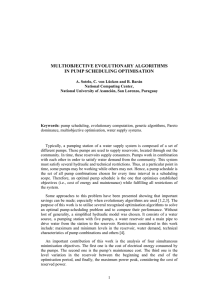
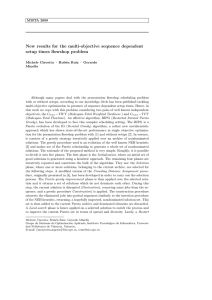
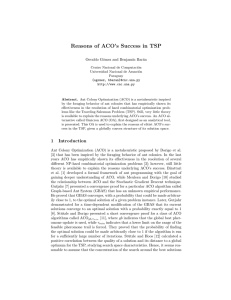
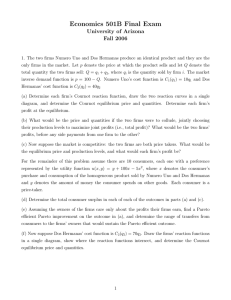
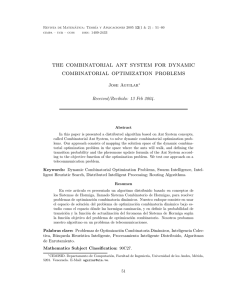
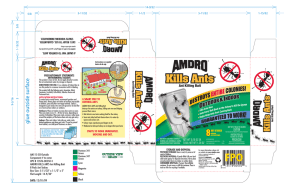
![29 † List of citizens newly attached [agregados] to the missions: To](http://s2.studylib.es/store/data/005935291_1-cce608f944c11df1f7b0591ad32e0ecf-300x300.png)
